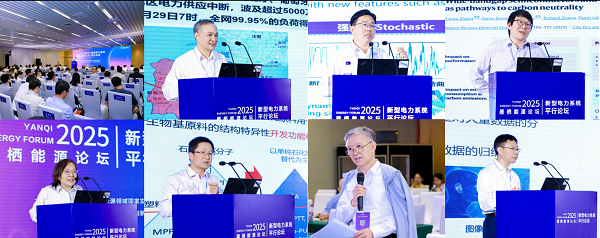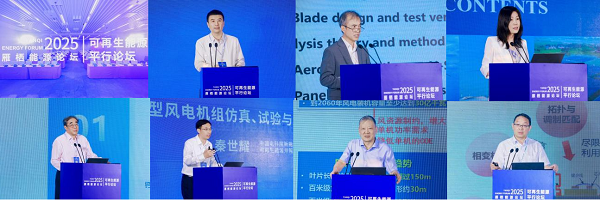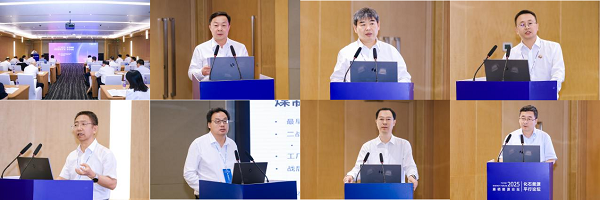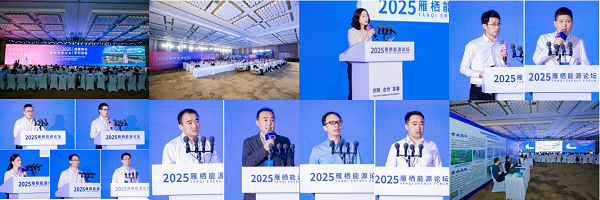Highlights of the Parallel Forums at Yanqi Energy Forum 2025
Release Time:2025-08-05
On July 31, 2025, Yanqi Energy Forum 2025, co-hosted by Huairou Laboratory and the National Energy Laboratory System Innovation Alliance, was successfully held. Themed “Energy Horizon: Innovation, Collaboration, and Development”, the forum focused on future development trends in the energy sector, key technological challenges, and innovative cooperation mechanisms. The event gathered global expertise, positioning innovation as the driving force and cooperation as the link, to jointly explore development pathways for the energy sector.
In the afternoon, parallel forums were held on next-generation power systems, renewable energies, hydrogen technologies, fossil energy technologies, PhD students perspective, and transformation of scientific and technological achievements.
Parallel Forum on Next Generation Power Systems
The Parallel Forum on Next Generation Power Systems focused on the critical needs for constructing next-generation power systems in line with China’s dual carbon goals. It was chaired by Liu Chaoqun, Director of Beijing Institute of Smart Energy of Huairou Laboratory.
Tang Yong, an expert from Huairou Laboratory research team, former Chief Engineer of the China Electric Power Research Institute, and Editor-in-Chief of the Proceedings of the CSEE, delivered a presentation titled “Analysis and Lessons from the April 28 Blackout in Spain.” He pointed out that the root cause of the blackout was overvoltage triggered by multiple interacting factors. He provided targeted recommendations aimed at strengthening power system development, including scientific planning of control measures, enhancing voltage regulation capabilities, and improving the support capacity of renewable energy power electronics equipment. He also emphasized the importance of establishing an efficient and reliable recovery mechanism for large-scale blackouts.
Sun Kai, Deputy Director of the Department of Electrical Engineering, Tsinghua University and Director of the Imperial-Tsinghua Research Center on Intelligent Power and Energy Systems, gave a presentation titled “Power Electronics for Supporting Flexible User-Side Resources in New Power Systems.” He proposed building self-organizing microgrids based on flexible interconnection converters, enabling flexible integration and efficient management of user-side resources. This approach would enhance microgrid stability and reliability and provide new technical tools for the utilization of user-side resources in new power systems. He also highlighted how artificial intelligence can empower power electronics technologies to achieve intelligent control and optimized dispatch of such resources.
Zhang Yuhao, Professor at the Advanced Semiconductor and Integrated Circuit Center of the University of Hong Kong, delivered a presentation titled “Research on Multidimensional Power Devices Based on Wide-Bandgap and Ultra-Wide-Bandgap Semiconductors.” He systematically reviewed recent advances in multidimensional structures of power semiconductor devices. Through novel architectures such as superjunction, multi-channel, and multi-gate designs, he explored how to overcome the traditional trade-off between conduction resistance and breakdown voltage without changing the material system. The application of multidimensional structures in Si, SiC, GaN, and UWBG devices opens new pathways to improving system efficiency, power density, and switching speed.
Xie Jingying, Deputy Director of the National Key Laboratory of Space Power Supply and CTO of the Shanghai Institute of Space Power-Sources, gave a presentation titled “Design and Engineering Applications of High-Power Electrochemical Energy Storage Systems.” He highlighted that integrating energy storage into frequency regulation has become a crucial method for enhancing performance, and that safety remains the prerequisite for large-scale deployment. Lithium titanate batteries, known for high safety, ultra-long lifespan, and rapid charge/discharge capabilities, are suitable for scenarios requiring stringent safety and long cycle life, such as the Yongxing Special Steel Hybrid Storage Plant, the Yuyao Guangyao Thermal Power Plant project in Ningbo, and the 18MW/4.5MWh lithium titanate hybrid storage project at China Resources Qiaokou Power Plant in Hunan.
Liu Xiaoqing, Researcher at the Ningbo Institute of Materials Technology and Engineering, Chinese Academy of Sciences, and member of the State Key Laboratory of Advanced Marine Materials, presented “Sustainable Epoxy Resins: From Bio-Based Materials to Controlled Chemical Recycling.” He highlighted progress in the synthesis of high-performance bio-based epoxy resins and placed particular emphasis on their industrial applications, as well as the latest research in transitioning toward chemically recyclable epoxy resins. He also showcased results from using laser-induced carbonization to convert bio-based thermoset resins into functional carbon-based composites.
Zhang Pei, Professor at the School of Electrical and Information Engineering of Tianjin University, presented “Scientific Paradigms and Research Frameworks for Intelligent Computing in Power Systems.” Focusing on the integration trend of distribution grids and transportation networks brought about by the rapid growth of electric vehicles and charging infrastructure, he discussed how to harness collaborative potential across sectors, build flexible vehicle-grid interaction regions, and achieve optimized operation of distribution networks. He also outlined key factors and challenges requiring special attention.

Parallel Forum on Renewable Energies
The Parallel Forum on Renewable Energies focused on technological breakthroughs, core challenges, and development pathways in the fields of wind power, photovoltaics, and other renewable energy sources. It was chaired by Yue Bo, Deputy Director of the Renewables Research Center of Huairou Laboratory.
Sun Yuping, an expert from Huairou Laboratory research team, delivered a presentation titled “Key Technologies, Current Status, and Prospects of Long Flexible Wind Turbine Blades.” He systematically explained achievements in aerodynamics, structural optimization, and integrated design of long flexible blades, offering mature pathways for the next generation of ultra-large power units.
Liu Zi, General Manager of China Three Gorges Renewables (Group) Co., Ltd., presented “Reflections and Practices in the Development of Large Wind and Photovoltaic Bases in Desert, Gobi, and Desertified Areas.” She emphasized the critical role of such bases in the construction of new energy systems, shared the company’s practical experience in building bases reaching ten gigawatts in scale, and proposed promoting technological innovation and deepening multi-energy complementarity to ensure balanced development between efficient transmission and local consumption.
Feng Zhiqiang, Deputy Director of the State Key Laboratory of Photovoltaic Science and Technology, delivered a presentation titled “Toward a New Era of Crystalline Silicon/Perovskite Tandem Technology.” He focused on innovations in crystalline silicon cell optimization and tandem technologies, highlighting Trina Solar’s achievements and reflections in both research and industrial applications.
Qin Shiyao, Executive Deputy Director of the State Key Laboratory of Renewable Energy Grid Integration, Director of the New Energy Research Institute of the China Electric Power Research Institute, and Yangtze River Scholar, presented “Key Technologies and Practices for Simulation, Testing, and Operation of Large Wind Turbine Units.” He pointed out that the large-scale development of wind turbines is key to China’s global leadership in wind power. To tackle related challenges, he proposed three solutions: independent simulation design software, all-condition testing platforms, and full-characteristic digital twin technologies.
Wang Tongguang, Chief Scientist of the National 973 Project, Director of the Jiangsu Key Laboratory of Hi-Tech Research for Wind Turbine Design, and Professor at the College of Aerospace Engineering, Nanjing University of Aeronautics and Astronautics, gave a presentation titled “Aeroelastic Stability Analysis and Optimization Technologies for Ultra-Large Flexible Blades.” He proposed a systematic technical framework for analyzing and optimizing the aeroelastic stability of ultra-large flexible blades, providing theoretical support and technical assurance for blade design.
Zhang Zhixue, Scientist at CRRC and a researcher at CRRC Zhuzhou Electric Locomotive Research Institute Co., Ltd., delivered a presentation titled “New Energy Grid-Forming Technologies and Applications.” Focusing on the challenges of high renewable penetration and high volatility grids, He proposed solutions utilizing virtual inertia and short-circuit current support, elaborated on the technological pathways and practical applications, and called for an improved standards system to promote integration between technologies and the market.

Parallel Forum on Hydrogen Technologies
The Parallel Forum on Hydrogen Technologies focused on the latest advances in hydrogen energy technologies and industrialization, as well as the opportunities and challenges facing the sector. The forum was chaired by Deng Zhanfeng, Deputy Director of the Fundamental and Frontier Research Center of Huairou Laboratory.
Li Xianguo, Academician of the Canadian Academy of Engineering and Professor at the University of Waterloo, delivered a presentation titled “Key Technologies of Hydrogen Fuel Cells for Large-Scale Green Hydrogen Applications.” He reviewed the three development waves of fuel cell technology, analyzed the current status and key challenges, and emphasized the need for breakthroughs through material innovation, intelligent manufacturing, and digital control. These strategies aim to resolve the “cost–durability–performance” dilemma and support the large-scale application of green hydrogen to achieve deep decarbonization.
Qu Zhiguo, Professor at Xi’an Jiaotong University, gave a presentation titled “Energy and Mass Transfer Characteristics and Enhancement Methods in Flue Gas Direct Electrolysis for Fuel Production.” His report focused on multi-scale transfer enhancement and engineering of this technology. Through a three-tier approach—impurity mechanism analysis, electrode mass transfer innovation, and system integration optimization—his team has brought the technology to the economic threshold for industrial applications, opening a new pathway for the resource utilization of industrial carbon waste.
Hua Zhengli, Distinguished Research Fellow at Zhejiang University, delivered a presentation titled “Key Challenges and Solutions for Large-Scale High-Pressure Hydrogen Storage and Transportation.” He pointed out that the core dilemma lies in balancing “economic feasibility” with “hydrogen embrittlement risk prevention.” He proposed a comprehensive innovation strategy combining materials, design, and testing to establish a complete system for large-scale hydrogen storage and transportation technologies.
He Ai, Associate Research Fellow at Tsinghua University, presented “Key Technologies for Hydrogen-Powered Aircraft Engines and Gas Turbines.” He argued that hydrogen-powered aircraft engines hinge on “revolutions in combustion, control, and thermal management,” while breakthroughs in gas turbines depend on “hydrogen blending retrofits for small- and medium-sized units and multi-carrier compatibility.” He emphasized the importance of industry–academia–research collaboration to overcome bottlenecks in cost reduction and operational safety, and highlighted the role of the “electric–hydrogen–electric” model in creating consumption pathways for green hydrogen to achieve decarbonization in both aviation and energy sectors.
Li Liming, Director of the Technology Department of PERIC Hydrogen Technologies Co., Ltd, shared a presentation titled “Opportunities, Challenges, and Strategic Reflections on the Overseas Expansion of Chinese Electrolyzers.” Against the backdrop of the global green hydrogen wave, he analyzed four major challenges facing the internationalization of electrolyzers and suggested a “localized production + international certification + scenario-based penetration” strategy to transform China’s cost advantages into sustainable competitiveness. He emphasized capturing trillion-yuan markets in green methanol and green ammonia while avoiding the pitfalls of low-price dumping.

Parallel Forum on Fossil Energy Technologies
The Parallel Forum on Fossil Energy Technologies focused on the clean and efficient use of fossil energy and its low-carbon transition. It was chaired by Zhi Dongming, Executive Deputy Director of the Xinjiang Base of Huairou Laboratory.
Guo Xusheng, Academician of the Chinese Academy of Engineering and Director of the State Key Laboratory of Shale Oil and Gas Enrichment Mechanisms and Efficient Development, presented his binary enrichment theory for shale oil and gas, which holds that “sedimentary environment is fundamental, while preservation conditions are critical.” This theory guided the discovery of the Fuling Gas Field and facilitated breakthroughs in deep and new strata shale gas exploration in the Sichuan Basin, as well as advances in shale oil exploration in the Jurassic formations of Sichuan and in eastern faulted basins.
Sun Yuanhui, Deputy Director of the State Key Laboratory of Enhanced Oil Recovery, introduced how PetroChina, leveraging the State Key Laboratory of Enhanced Oil Recovery, has deepened basic theoretical research, tackled core technologies such as chemical flooding, CCUS-EOR, and SAGD for heavy oil, and promoted their large-scale application. These efforts have achieved multiple landmark breakthroughs, including maintaining stable production of tens of millions of tons for 24 consecutive years. The future goal is to further raise the recovery rate by 10 to 25 percentage points.
Niu Yuguang, Deputy Director of the State Key Laboratory of New Energy Power Systems, analyzed the issues and challenges of flexible operation of coal-fired units under the context of new energy power systems. He proposed research directions on key scientific and technological problems, including intrinsically flexible main and auxiliary equipment, system restructuring with integrated energy storage, automatic control for dynamic energy-quality matching, and optimized intelligent operation under all working conditions.
Liu Xinying, Academician of the African Academy of Sciences and the Academy of Science of South Africa, noted that modern coal chemical industries face challenges of high CO₂ emissions and low value-added products. On one hand, it is necessary to reduce feedstock costs by developing gasification technologies for low-rank coal; on the other, new coal-to-liquid processes that integrate oil and chemical production must be developed to allow flexible switching between oil and chemicals.
Chu Jingchun, Chief Scientist of China Energy Investment Corporation, presented the application of gigawatt-hour-scale molten salt heat storage coupling technologies. Through system optimization and multi-effect integration, these technologies achieve decoupling of heat and power and cascading utilization of thermal energy. He highlighted the Suzhou thermal power demonstration project, which has more than doubled the peak-shaving capacity of the power units.
Gao Shiwang, Deputy Director of the State Key Laboratory of High-Efficiency Flexible Coal Power Generation and Carbon Capture Utilization and Storage, analyzed the significance, challenges, and research progress of CCUS for achieving China’s dual carbon goals. He introduced the Huaneng Longdong Demonstration Project and stressed the need to overcome policy and technical obstacles to advance CCUS development.

Parallel Forum - PhD Students Perspective
The Parallel Forum - PhD Students Perspective attracted more than 40 PhD students from 10 universities, including Tsinghua University, Zhejiang University, and Xi’an Jiaotong University. The forum centered on the theme “Artificial Intelligence Empowering Energy Science and Technology.” The opening remarks were delivered by Wang Li, Deputy Secretary-Generalof Huairou Laboratory, and the session was chaired by Liu Jin, Director of the Department of Graduate Affairs.
Fu Wei, a doctoral student at Xi’an Jiaotong University, presented “Quantum Computing Empowering Resilience Enhancement of New Power Systems.” He discussed a new paradigm of quantum-classical hybrid-driven decision-making for disaster defense and rapid recovery in power systems.
Jiang Yiwei, a doctoral student at Zhejiang University, presented “Research on Intelligent Olfactory Sensors Based on High-Throughput Screening.” She proposed innovative approaches to enhance sensor sensitivity through machine learning.
Liu Xianzhe, a doctoral student at Huazhong University of Science and Technology, focused on “Machine Learning Prediction Models for Thermal Solvent Extraction of Low-Rank Coal.” He developed a multidimensional kinetic method based on big data models.
Ma Xingxing, a doctoral student at Huairou Laboratory, presented “ML-Based Predictions of Low-Rank Coal Structures and Pyrolysis Product Distributions.” He introduced the fifth-generation data-driven model for pyrolysis product distribution integrating coal structures.
Pang Jupeng, a doctoral student at Tsinghua University, gave a presentation on “Research on Topologies, Modulation Control, and Integrated Packaging of Multilevel DAB Converters.” He reported on the evolution of converter topologies, control strategies, and integrated packaging of multilevel power modules, and introduced the application of AI in fault diagnosis of multilevel converters.
Shi Yuanhong, a doctoral student at the University of Chinese Academy of Sciences, presented “Atomic Confinement Intercalation Technology for Gallium Nitride Devices,” offering a new platform for breakthroughs in semiconductor material performance.
Wang Tao, a doctoral student at Hunan University, shared his research on “Large-Model-Enhanced Photovoltaic Forecasting and Voltage Regulation in Distribution Networks,” exploring AI applications in renewable energy systems.
Wang Yuqing, a doctoral student at North China Electric Power University, introduced “Ultra-Short-Term Power Forecasting Methods for Clustered Distributed Photovoltaics Based on Spatiotemporal Correlation Modeling.” He explained how efficient modeling of spatiotemporal correlation information can optimize and improve photovoltaic power accuracy.
Wu Wentong, a doctoral student at Huairou Laboratory, analyzed “Failure Mechanisms and Modification Strategies for NiFe-Based Electrodes.” He proposed optimization strategies to improve the performance of alkaline hydrogen production electrodes under industrial conditions.
Zhang Xiyuan, a doctoral student at Huairou Laboratory, demonstrated “AI-Driven Large-Area Fuel Cell State Reconstruction,” showcasing innovative AI applications in fuel cell health management.
The forum invited a panel of five distinguished judges: Professor Yang Geng from Tsinghua University, Professor Yang Xu from Xi’an Jiaotong University, Professor Xu Jinliang from North China Electric Power University, Mr. Shao Tao from the Institute of Electrical Engineering, Chinese Academy of Sciences, and Director Lin Zhiguang from the China Electric Power Research Institute. Based on academic innovation, practical value, and on-site performance, they selected three winners of the Best Performance Award and seven winners of the Outstanding Academic Report Award.

Parallel Forum on Transformation of Scientific and Technological Achievements
The Parallel Forum on Transformation of Scientific and Technological Achievements under the theme of “Energy Innovation · Empowering Industry” focused on the bottlenecks in the industrialization of scientific and technological achievements in the energy sector. It brought together leading energy technology enterprises, core laboratory teams, top financial institutions, and government departments to create a high-level dialogue platform for deep integration of government, industry, academia, research, and finance. The forum featured opening remarks by Chen Xuemei, Deputy District Mayor of Huairou District, and was chaired by Hu Jilong, Deputy Director of the Huairou District Science and Technology Commission.
1. In-Depth Sharing of Industrial Practices
Xu Longze, General Manager of China-EPRI Electric Power Engineering Company Limited, delivered a keynote report titled “Empowering Enterprises with Scientific and Technological Achievements for High-Speed Development.” He shared practical experiences and successful models of central state-owned enterprises in the field of technology commercialization.
Yang Rong, Deputy General Manager of the Innovation Division of the China Automotive Battery Research Institute (CABRI), presented “Commercialization of High-Performance Batteries and Key Materials.” His report covered breakthrough pathways and industrialization solutions in cutting-edge areas such as ternary batteries, high-nickel materials, lithium-rich manganese-based materials, and all-solid-state batteries.
2. Sharing of Technology and Commercialization Pathways
Industry-leading enterprises and Huairou Laboratory teams conducted in-depth exchanges on the technical characteristics, development directions, and commercialization pathways of key projects such as capacitors, IGCT devices, converter equipment, submarine cables, and silicon carbide.
Yu Zhiqiang, Chief Engineer of the Capacitor Business at SUN.KING Technology Group Limited, elaborated on the “R&D Progress of Dry-Type DC Support Capacitors for Flexible DC Converter Valves.”
Dong Kang, Scientist from the Institute of High Energy Physics of the Chinese Academy of Sciences, showcased applications of the High Energy Synchrotron Radiation Light Source in driving innovation in the energy industry.
Huairou Laboratory researchers Xue Qing, Liu Rui, and Li Xuebao respectively shared the process of overcoming bottlenecks and the phased commercialization achievements of independent high-voltage cables, IGCT devices and converter equipment, and silicon carbide power devices.
From a capital perspective, leading financial institutions such as the China Development Bank and Zhongguancun Capital provided in-depth insights into technological innovation trends, investment preferences, and successful cases. They analyzed the investment logic in the energy technology sector and explained how the capital chain can empower the innovation ecosystem.
Yang Jianjun, Deputy General Manager of the Energy and Water Resources Division of the China Development Bank, shared the practical model of “Policy Finance Supporting the Industrialization of Energy Technology Innovation.”
Zhou Chao, Assistant General Manager of Zhongguancun Capital Fund Management Co., Ltd., explained the investment philosophy of “Patient Capital for Deeply Supporting the Nation’s Strategic Scientific and Technological Strength.”
4. Building a Policy Support System
The final session focused on industrial resources and interpretation of government policies.
Chen Da, Deputy General Manager of Huairou Science City Technology Services Co., Ltd., introduced a special service model titled “Leveraging Industrial Resources to Facilitate the Commercialization of Energy Technology Achievements.”
Yi Mingjiang, Director of the Huairou District Science and Technology Commission, delivered a report on “Science, Technology, and Industrial Policies in Huairou District,” providing detailed explanations of localized policy packages, including pilot-scale base support, talent recruitment, and tax incentives.
The forum comprehensively showcased Huairou District’s “policy toolbox” for building an energy innovation ecosystem. By leveraging the cluster advantages of strategic scientific and technological forces in the energy sector at Huairou Science City, and by aligning the innovation chain with the industrial chain, the district is committed to creating a model regional energy innovation ecosystem and advancing the in-depth development and deployment of new energy systems in Huairou.





